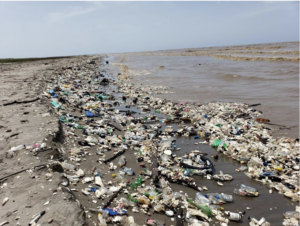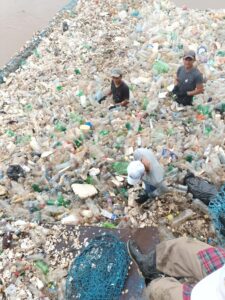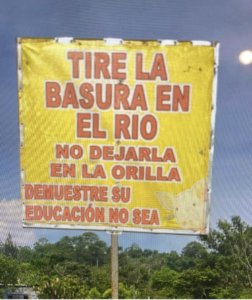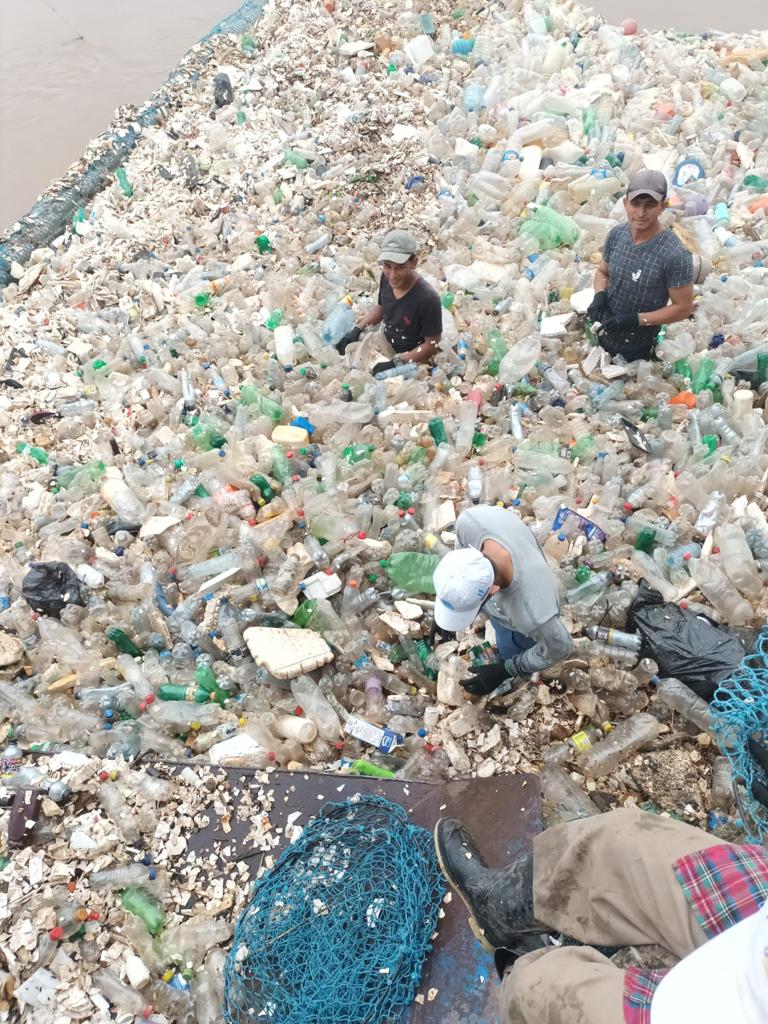By Natalia Luque, ESRAG Latin America Correspondent
What brought together many Rotary Clubs of Guatemala, Honduras and Belize, government entities of those nations, and more than 25 private companies in a common pact? The answer is a river with the largest watershed in Guatemala. With approximately 486 km in length, the Río Motagua has become a sewer or landfill instead of a river along its basin and its surrounding beaches.

One of the Caribbean beaches polluted by solid waste carried by the Rio Motagua.
Nearly 15,000 TN of waste per year flow into the Motagua River from the Las Vacas River and about 3,500 TN from the Guatemala City landfill. Almost 6,000 TN of this waste remain on the banks of the river, and the rest – between 10,000 and 12,000 tons – travels downstream and flows into the Caribbean Sea and the surrounding beaches, especially those of Honduras. The situation worsens in the rainy season, during the floods. One of the natural flooding zones of the river, located right in zone 3 of the landfill, undermines the buried waste, which ends up in the river. Preliminary analysis carried out to date indicate that this river is contributing almost 2% of the total plastic oceanic pollution of the world.
When I met with a group of passionate and committed Rotarians from Central America, who explained the complexity of the river problem to me, what resonated most in those conversations is the Rotary motto of “People of Action.” This gigantic and ambitious project is a clear example of the power that our clubs have when they join forces and knowledge, structure a concrete action plan in phases, and work hand in hand with organizations and government entities for a common goal.
These Rotarians from several Clubs and three Central American countries began by taking the initiative to contact various NGOs to seek support to begin the installation of an interceptor mechanism capable of removing tons of waste before it reaches the ocean. But quickly they realized that the project had to address the problem from the base, and also that they needed specific phases and fronts of action and to involve different government entities to achieve long-term solutions. Hence the “Alliance for the Motagua River” was born. This project was showcased during the Adopt-a-River talk at Rotary’s paviliion at COP 28 (beginning at minute 16).
To launch the initiative, Rotarians began by documenting the magnitude of the problem. They called meetings with local communities and different local government entities, and obtained the support of more than 25 private organizations willing to contribute money and technology to the project. The agreement was signed on September 25, 2023 in Guatemala, with the accompaniment and support of Rotary International President Gordon Mclnally and the Governor of Rotary District 4250 (Guatemala, Honduras, and Belize), María Price.

Workers collecting garbage at one of the interceptor sites on the river.
This mega-project has several phases. The placement of interceptors has already been underway for some time. The different Rotary Clubs along the watershed are working on training and raising awareness of local communities, especially to abolish the longstanding practice of throwing waste into the river – a practice that not only remains in force, but surprisingly continues even to be encouraged by local advertisements. These Rotary campaigns seek to reduce the amount of waste thrown into the river, encouraging water care, basic sanitation, recycling, and reuse of materials.
Additionally, Rotarians have contributed ideas, knowledge and logistics, to ensure that the Alliance and the resources allow the construction of a diversion canal for the Motagua River. This will move its course away from the landfill, thus preventing a very significant volume of waste from ending up in the river. The project also seeks the placement of new interceptors and areas for the collection and separation of waste collected in key areas of the river, to remove the accumulated garbage before it reaches the sea. Private entities and various NGOs are providing resources for this work, and Rotarians are seeking to advise local governments on the review and improvement of waste management policies throughout the basin and the construction of new landfills, or the implementation of new technologies for waste

Rotarians are working to convince communities to change long-held practices. This sign reads: “throw the garbage in the river. Don’t leave it on the bank. Show that you are educated: don’t be a pig!”
management.
To prevent pollution like that of the Río Motagua, Rotarians can all contribute directly and indirectly. The change begins at the source, including our homes and clubs. We can evaluate if we are separating the waste at home properly, as well as at our meetings. Are we organizing the meetings and activities of our Clubs with environmental awareness? Making each event promote environmental awareness is very important. We can use reusable or compostable items, instead of disposable ones.
We can promote activities that invite people to give a second chance to objects that are still useful. Using our knowledge and skills we can offer repair activities for objects, appliances and clothing to serve our community.
We all have a “Motagua River” close by. Together, by uniting the strengths, knowledge and contacts of our Clubs, we can make a difference, as Central American Rotarians are doing in this inspiring project.
Natalia Luque is a biologist and member of the Club Global Zipaquirá in Colombia.

